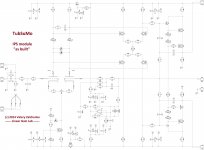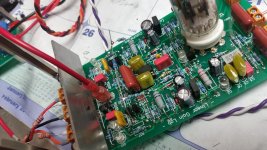Attachments
Yes, I can, as always 🙂
Regards,Alex
Beautiful, Alex!
What PC board design software do you use?
Ray
My BipSuMp inputs work perfectly. 1mV offset on one and 3mV offset on the other. 1.6V between ND and PD with 100 ohm resistors to NFB. Both are pretty much identical in operation. Both have -200 mV DC offset with the servo pulled. It looks like matching devices (other than mismatched gain ranks on A1381/C3503) has helped. I have 2 sets of matched devices waiting to go into the TubeSoMo inputs. Hopefully that fixes them up.
My BipSuMp inputs work perfectly. 1mV offset on one and 3mV offset on the other. 1.6V between ND and PD with 100 ohm resistors to NFB. Both are pretty much identical in operation. Both have -200 mV DC offset with the servo pulled. It looks like matching devices (other than mismatched gain ranks on A1381/C3503) has helped. I have 2 sets of matched devices waiting to go into the TubeSoMo inputs. Hopefully that fixes them up.
Perfect!
8mA VAS current - exactly as designed.
200mV with no servo is a pretty good balance.
Looking forward to seeing your tube- ones working as well 😉
I've been battling with the tube inputs a little more. I've switched them to BJT inputs for comparison. DC offset is now gone completely. The board that I thought didn't have enough VAS current is actually perfect. The board that I thought was good actually has too much VAS current. It will likely be easier to find the VAS issue on the defective board.

I've been battling with the tube inputs a little more. I've switched them to BJT inputs for comparison. DC offset is now gone completely. The board that I thought didn't have enough VAS current is actually perfect. The board that I thought was good actually has too much VAS current. It will likely be easier to find the VAS issue on the defective board.
Interesting...
For the beginning - if you can measure the voltages on both boards:
- across D3, D7 LEDs;
- across R29 resistor (150R).
And then we'll see.
At the same time, it looks like you've got some problem with the tubes. Are you sure, the "heating" voltage (6.3V AC) is stable enough? In case it is lower, than that, anode current is somewhat lower than expected, resulting in "inadequate" operation...
Attachments
Bad board D3 1.644 D7 1.647 R29 .468
Good Board D3 1.657 D7 1.653 R29 .475
I've got a matched set of LEDs waiting to go into these boards. There wasn't much variation in any I measured though.
Good Board D3 1.657 D7 1.653 R29 .475
I've got a matched set of LEDs waiting to go into these boards. There wasn't much variation in any I measured though.
One other odd thing I found before I switched to BJT was the bad board wasn't bad for DC offset. Under 10mV. The good board was around 45-60mV when swapping tubes between the two, so there's an issue with the servo of feedback on that board still.
The set I've been listening to got no parts matching. Could be dumb luck that it worked for me.
The set I've been listening to got no parts matching. Could be dumb luck that it worked for me.
I've got 4 boards running here with matched parts and still have an odd problem on one. It's got to be either a bad resistor or a diode.
The set I've been listening to got no parts matching. Could be dumb luck that it worked for me.
I only matched the front-end transistors checked for hfe difference, keeping it not more than 50%. The circuit balances itself out pretty well, allowing rather high tolerances. If it doesn't - most likely there's a faulty part somewhere.
Matched LEDs made D3 and D7 both 1.65. R29 is .483 now.
OK, this is good. So now, if one board is showing the VAS current too low, the problem is most likely in VAS itself...
Sitting here staring at the schematic makes me think the issue should be narrowed down to R23 or R20 being wrong values. They measure good and the servo works but I think I'll swap them and see what happens. Vas rises quickly on start up. Maybe one drifts as it warms up.
The only ones left are Q4-Q7. Voltage drop over 680R at their collectors has to be close to equal.
- Home
- Amplifiers
- Solid State
- Ultra-high performance, yet rather simple - hybrid and more!

